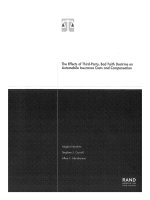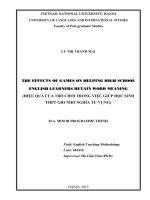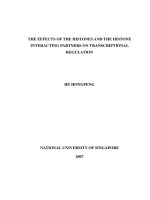the effects of corporate culture on organisational effectiveness at general department of vietnam customs
Bạn đang xem bản rút gọn của tài liệu. Xem và tải ngay bản đầy đủ của tài liệu tại đây (503.43 KB, 59 trang )
MINISTRY OF FINANCE
ACADEMY OF FINANCE
FACULTY OF FOREIGN LANGUAGES
-----*****-----
GRADUATION THESIS
THE EFFECTS OF CORPORATE CULTURE ON
ORGANISATIONAL EFFECTIVENESS AT
GENERAL DEPARTMENT OF VIETNAM CUSTOMS
VÕ THÙY LINH
CQ47/51.03
Hanoi – 2013
MINISTRY OF FINANCE
ACADEMY OF FINANCE
FACULTY OF FOREIGN LANGUAGES
-----*****-----
THE EFFECTS OF COPORATE CULTURE ON
ORGANISATIONAL EFFECTIVENESS AT
GENERAL DEPARTMENT OF VIETNAM CUSTOMS
SUMBMITTED IN PARTIAL FULFILMENT OF THE
REQUIREMENTS FOR THE DEGREE OF BACHELOR OF ARTS IN
ENGLISH FOR FINANCE AND ACCOUNTING
Student
Class
: Võ Thùy Linh
: CQ47/51.03
Supervisor : M.A Trương Thị Minh Hạnh
Hanoi - 2013
Graduation thesis
Faculty of Foreign Languages
DECLARATION
I hereby declare that this thesis is based on my own work except for
quotations and citations which have been acknowledged. I also declare that it
has not been submitted for any other course/degree at Academy of Finance or
other institutions.
Hanoi, May 3th 2013
Student‘s name
Võ Thùy Linh
Võ Thùy Linh
i
CQ47/51.03
Graduation thesis
Faculty of Foreign Languages
ABSTRACT
Corporate culture contributes to enhance organisational effectiveness at an
organisation. Corporate culture is a process where norms, values, and
coordination and integration characteristics are at play. Companies or
organisations need to build positive corporate culture not only for running a
company but also for enhancing the effectiveness of it. It is also significant
for a company or an organisation to know who its employees are, how they
interract with each other and how they achieve common goals. This study
examines the characteristics of corporate culture: norms, values, and
coordination and integration at the GDVC. A questionnaire and interviews are
used to collect data about corporate culture and its impacts on the
organisational effectiveness at the GDVC. The preliminary results of the
research show that initially the GDVC with a healthy corporate culture is
more confident and motivated. The conclusion research results, some
recommendations for improving the corporate culture will also can also be
drawn a healthy corporate culture positively impacts on the organisational
performance. Following an in-depth multi-dimentional analysis of preliminary
be presented.
Võ Thùy Linh
ii
CQ47/51.03
Graduation thesis
Faculty of Foreign Languages
ACKNOWLEDGEMENTS
This graduation thesis would not have been possible without the guidance and
the help of several individuals who in one way or another contributed and
extended their valuable assistance in the preparation and completion of this
study.
First and foremost, I would like to express my gratitude to my thesis
supervisor M.A Trương Thị Minh Hạnh for her inspiring guidance,
suggestions and critical evaluation of the work for the successful completion
of my thesis.
Secondly, I would like to give thanks to all lecturers at Academy of Finance
for their enthusiasm through the teaching and support process.
Thirdly, I would like to express my sincere thanks to all staff of the General
Department of Vietnam Customs for giving me assistance and corporation
that helped me in writing this thesis.
Last but not least, I would like to thank my family members and friends for
their essential encouragement during the process of completing this thesis.
Hanoi, May 2nd, 2013
Võ Thùy Linh
Võ Thùy Linh
iii
CQ47/51.03
Graduation thesis
Faculty of Foreign Languages
LIST OF TABLES
Figure 2.1 Organisational structure of General Department of Vietnam
Customs …………………………………………………………………… 22
Võ Thùy Linh
iv
CQ47/51.03
Graduation thesis
Faculty of Foreign Languages
LIST OF ABBREVIATIONS
ASA
Attraction – Selection – Attrition
GDVC
General Department of Vietnam Custom
IT
Information technology
M.A
Master of Arts
Võ Thùy Linh
v
CQ47/51.03
Graduation thesis
Faculty of Foreign Languages
TABLE OF CONTENTS
DECLARATION ............................................................................................... i
ABSTRACT ...................................................................................................... ii
ACKNOWLEDGEMENTS ............................................................................. iii
LIST OF TABLES ........................................................................................... iv
LIST OF ABBREVIATIONS ........................................................................... v
TABLE OF CONTENTS……………………………………………..........vi
INTRODUCTION............................................................................................. 1
1. Rationale ..................................................................................................... 1
2. Aims of the study ........................................................................................ 2
3. Scope of the study ....................................................................................... 2
4. Methodology ............................................................................................... 2
5. Organisation of the study ............................................................................ 2
CHAPTER 1...................................................................................................... 4
LITERATURE REVIEW ................................................................................. 4
1.1.Corporate culture......................................................................................... 4
1.1.1. Definition .......................................................................................... 4
1.1.2. Characteristics of corporate culture .................................................. 6
1.1.2.1. Norms (Behaviors) ................................................................... 6
1.1.2.2. Values....................................................................................... 8
1.1.2.3. Coordination and Integration ................................................. 10
Võ Thùy Linh
vi
CQ47/51.03
Graduation thesis
1.2.The
relationship
Faculty of Foreign Languages
between
corporate
culture
and
organisational
effectiveness .............................................................................................. 12
1.2.1. Organisational effectiveness ........................................................... 12
1.2.2. The impacts of corporate culture on organisational effectiveness 13
1.2.2.1. Positive impacts ..................................................................... 13
1.2.2.2. Negative impacts .................................................................... 14
1.2.3. Healthy and Unhealthy corporate culture ....................................... 15
1.2.3.1. Healthy corporate culture....................................................... 16
1.2.3.2. Unhealthy corporate culture................................................... 16
1.2.3.3. Building and maintaining a positive corporate culture .......... 17
CHAPTER 2.................................................................................................... 20
THE STUDY ................................................................................................... 20
2.1.Introduction about the General Department of Vietnam Customs ........... 20
2.1.1. Development history ....................................................................... 20
2.1.2.Organisational structure………………………………………….21
2.2.Corporate culture at the GDVC ................................................................ 26
2.2.1. Analyzing Norms at the GDVC ...................................................... 26
2.2.2. Analyzing Values at the GDVC...................................................... 29
2.2.3. Analyzing Coordination and Integration at the GDVC .................. 31
2.2.4. The influences of corporate culture on organisational effectiveness
at the GDVC ............................................................................................. 34
2.3.Mini conclusion......................................................................................... 35
Võ Thùy Linh
vii
CQ47/51.03
Graduation thesis
Faculty of Foreign Languages
CHAPTER 3.................................................................................................... 36
RECOMMENDATIONS ................................................................................ 36
3.1.Summary of the findings ........................................................................... 36
3.2.Suggestions for improving the corporate culture at the GDVC ............... 37
CONCLUSION ............................................................................................... 42
REFERENCES ................................................................................................ 43
APPENDIX ..................................................................................................... 45
Võ Thùy Linh
viii
CQ47/51.03
Graduation thesis
Faculty of Foreign Languages
INTRODUCTION
1. Rationale
Over the past decades, many scholars and experts have conducted extensive
study on corporate culture which is essentially the sum total of norms,
behaviors, values, coordination and integration of an organisation. It
encompasses the collective goals of a company or an organisation and
standards of expected behaviors in achieving the goals. Every organisation,
from small businesses to large ones, has a culture deciding the way employees
interact at their workplaces and the effectiveness of organisation in the future.
However, Vietnamese enterprises or organisations mostly have not
understood or misunderstood the corporate culture and its values. Therefore, it
is very important to study corporate culture and its effects on the
organisational effectiveness in Vietnam.
Culture can affect business performances in a number of ways, both positive
and negative. Corporate culture has a vital and measurable impact on the
organisation‘s ability to deliver on its strategy. It is imperative that enterprises
and organisations do not ignore or underestimate the effects of corporate
culture on the organisational performance. A healthy corporate culture values
each employee in the organisation regardless of his job duties, which results
in employees working as a team to meet the company‘s and their own
personal needs. On the contrary, in a business with an unhealthy corporate
culture, employees act as individuals, performing their duties to meet their
own needs.
Realising the important role corporate culture has in organisational success, I
chose topic ‗corporate culture‘for my research paper. This paper focuses on
“The effects of corporate culture on organisational effectiveness at
Võ Thùy Linh
1
CQ47/51.03
Graduation thesis
Faculty of Foreign Languages
General Department of Vietnam Customs” with the expectation of
enhancing the effectiveness at General Department of Vietnam Customs.
2. Aims of the study
The aim of this study is to define and measure the corporate culture and its
impacts on the organizational performance. It also aims to analyse the existing
corporate culture of General Department of Vietnam Customs and its effects
on the organizational performance.
3. Scope of the study
Because of the limited time and the scale of the research, and for the
thoroughness of what is done, this research paper only deals with the
following questions:
What are the aspects of corporate culture at General Department of
Vietnam Customs?
What are the impacts of corporate culture on the organisational
effectiveness at General Department of Vietnam Customs?
4. Methodology
A questionnaire and interviews are used to collect the reliable data at General
Department of Vietnam Customs.
5. Organisation of the study
Apart from the INTRODUCTION, CONCLUSION, REFERENCES and
APPENDIXES, the main content is divided into three chapters as follows:
Chapter 1 - LITERATURE REVIEW gives a general overview on corporate
culture, and its impacts on the organisational effectiveness.
Chapter 2 - THE STUDY analyses the current situation of corporate culture
at General Department of Vietnam Customs
Võ Thùy Linh
2
CQ47/51.03
Graduation thesis
Faculty of Foreign Languages
Chapter 3 – RECOMMENDATIONS summarizes the findings of the study
and suggestions for the company to create a positive corporate culture.
Võ Thùy Linh
3
CQ47/51.03
Graduation thesis
Faculty of Foreign Languages
CHAPTER 1
LITERATURE REVIEW
1.1. Corporate culture
1.1.1. Definition
In large society, an enterprise or an organisation is considered as a miniature
society. The large society has a mass culture; the small society (business)
needs to build itself a separate culture. The corporate culture influences and is
also component of the general culture.
Corporate (organisational) culture can be difficult to define and even harder to
change. It is essentially the sum total of the attitudes, behaviors, beliefs, and
traditions of an organisation. It encompasses the collective goals of
organsational and the standards of expected behavior in achieving those goals.
And it describes the environment and manner in which employees interact
with each other and the market.
There are many ways to define the corporate culture, which paints the clear
painting about the corporate culture. Pettigrew (1979) argues that cultures of
organsation based on cognitive systems which help to explain how employees
think and make decisions. He also notes the different level of culture based on
the multifaceted set of beliefs, values and assumptions that determine ways
for organisations to conduct its business.
According to Gareth Morgan (1997)‘s culture is as ―the set of beliefs, values,
and norms, together with symbols like dramatized events and personalities,
which represents the unique character of an organisation, and provides the
context for action in it and by it‖. He refers to characteristics of corporate
culture, such as norms, values, beliefs, which distinguishes an organisation
Võ Thùy Linh
4
CQ47/51.03
Graduation thesis
Faculty of Foreign Languages
from others and helps to enhance the effectiveness of organisation in the
future.
In relation to the above definition, Brown (1990) defines organisational
culture (also refer to corporate culture) as ―the pattern of beliefs, values, and
learnt ways of coping with experience that have developed during the course
of an organisation‘s history, and which tend to be manifested in its material
arrangements and in the behaviors of its members‖ (Brown, 1990, p9). He
maintains if an organisation builds corporate culture during the course of its
history, it will be shown through the performance of organisation good or
bad.
According to Edgar Schein (2004), a professor of organisation research in
America, corporate culture is considered as ―the system of shared beliefs,
values and standards of solving problems, which is created in the forming and
developing process of a corporation and demonstrated through physical and
nonphysical forms and behaviors of its members‖. This is the most popular
definition which is used to define the corporate culture. He notes that
corporate culture has a key role in success and effectiveness of an
organisation.
Võ Thùy Linh
5
CQ47/51.03
Graduation thesis
Faculty of Foreign Languages
1.1.2. Characteristics of corporate culture
1.1.2.1. Norms (Behaviors)
According to the Oxford advanced Learner‘s dictionary, norms are standards
of behavior that are typical of or accepted within a particular group or society.
And Hodgetts and Luthans (2003) believe that norms are measured by things
like amount of work done and also the level of corporation between
management and employees of the organisation. Norms refer to specified
modes of prescribed or socially sanctioned behaviors (Effective management
control by Enc Flamholtz).
The origin of Wealthy by E.D Beinhocker undermines the position that
cultural norms are in short the rules of thumb for behaving in a social
environment. Norms are ―should‖ or ―ought‖ statement about what is
considered the right, appropriate, or the expected thing to do, by the society or
organisation in a given situation. Every person has an individual set of rules
of behaviors that he or she follows. For example, people at Matsushita might
all share human norms, Japanese norms, and various Matsushita
organisational norms, but they are still individuals and will differ in their
behaviors. There are many kinds of norms, such as idiosyncratic norms,
organisational, societal, or human norms. The way we can distinguish
between them is to ask how widely shared the norms are.
In other sense, norm is obviously a cultural affects that organisational
performance. If all (or even most) of the employees in a company behave in
particular way, that behavior will affect the company overall performance.
The more interesting question is which behaviors are desirable, and which
ones are not. Naturally, norms that contribute to company success are likely to
Võ Thùy Linh
6
CQ47/51.03
Graduation thesis
Faculty of Foreign Languages
be highly specific to a company, its industry, its particular business plans, the
competitive circumstances, and so on.
In Beinhocker‘s view, each kind of norms plays a critical role in the executing
versus adapting story and in reducing the dependency of the organisation on
structure and process. It is virtually impossible for a set of norms that is
balanced across individual performance, cooperation, and innovation to arise
organically without strong leadership.
Russell, in a study of small to medium size businesses, finds that a set of
norms are significantly related both to the absolute number of innovations
successfully implemented in the organisations and to the frequency and
importance of innovation as an element of organisational strategy. Seven
norm dimensions are identified that are associated with reinforcing behaviors
which are associated with innovation. These norms dimensions are: (1)
support of individual creative activities, (2) recognition of innovation as an
appropriate solution to organisational problems, (3) free and open exchange if
information both inside the organisation and with external agents, (4) openminded consideration of new ideas, (5) commitment to the development of
new ideas by providing psychological and resource support, (6) support of
moderate risk-taking in new ventures, and, (7) support for the effective
implementation of change.
So, norm helps employees distinguish between what has been tried and
succeeded and those things that were attempted but failed; it allows staff to
move beyond past failures through to innovation and achievement, which
assesses the effectiveness of organisation now and in the future.
Võ Thùy Linh
7
CQ47/51.03
Graduation thesis
Faculty of Foreign Languages
1.1.2.2. Values
A culture‘s values are its ideas about what is the good, right, fair and just
(Oxford advanced Learner‘s dictionary). An organisaional value is ―a belief
that a specific mode of conduct is preferable to an opposite or contrary mode
of conduct‖ according to Rokeach (1973, The Nature of Human Values).
Some organisations think or their values as their ―guiding beacon‖ directing
the process of organisational development and growth. Others describe them
as the components of their philosophy. They do relate to how organisational
deal with their beliefs about people and work. More and more studies show
that successful companies place a great deal of emphasis on their values.
Hofstede (1980)‘s study indicates that cultural values reliably distinguish
national subsidiaries of a multinational corporation. Values belong to people
more than to organsations and, organisations import values more than they
create them. Analysing of values, therefore, may be of particular significance
to the recruitment and selection sub-system within organisations.
Values are important building blocks of culture and are deep-seated and
enduring. They motivate behavior and emotional responses; they underpin the
way people approach their work, make choices and decisions, and deal with
each other. The leadership of an organisational is responsible for the creation
and management of its culture and should aim to achieve the link between
manager‘ and employees‘ individual values and the organisational values.
At work, values assist organisation and its employees by providing a
framework for how staff treat one another and customer; helping staff make
sense of working life; providing a framework for achieving the vision and
increasing the effectiveness of the organisation; creating an environment
Võ Thùy Linh
8
CQ47/51.03
Graduation thesis
Faculty of Foreign Languages
conducive to job satisfaction as well as finding work which is exciting and
challenging; and differentiating one organisation from another.
Values play an important role in creating the effectiveness of organsation
because of some reasons. People are increasingly aware of organisational
values and look for them, frequently choosing one organsation over another
because of their values. Values provide the basis for achieving culture change,
help enable people and organisations to succeed and impact on professional
practice. It is a highly competitive world and values help show customers of
organisation how it is different from other providers and potential staff and
how it differs from other prospective employers because they say ―this is what
we value here‖.
Values are the essence of corporate culture because they set out the ―do‘s‖
and ―don‘ts‖ around here! Living them is what really counts. They are not
made to be put up on the wall and forgotten about! Values vary from one
organisation to another. However there should be a few core values only, they
should be symbolised by one word, then have a brief definition of what that
means in reasonably global terms, followed by defined behaviors. They
support vision, shape culture and reflect what an organisation values.
Therefore, ultimately, whether we are talking about high performance, brand
differentiation, or retaining talented individuals, the success of organisation is
directly related to the degree of alignment that exists between the underlying
values of the leaders and the desired values of employees.
Võ Thùy Linh
9
CQ47/51.03
Graduation thesis
Faculty of Foreign Languages
1.1.2.3. Coordination and Integration
Coordination and integration in corporate culture are for the purpose of
improvement in efficiency to works, quality and speed of designing,
manufacturing the products and services. They impact the effectiveness of an
organisation.
Firstly, coordination is the unification, synchronization of the efforts of group
members so as to provide unity of action in the pursuit of common goals. It is
a hidden force which binds all the other functions of management. According
to Charles Worth (1895) says, ―Coordination is the integration of several parts
into an orderly hole to achieve the purpose of understanding‖. He notes that
an organisation wants to achieve its goals, all staff need to promote the unity
of thinking and actions.
Management seeks to achieve coordination through its basic functions of
planning, organizing, staffing, directing and controlling. That is why coordination is not a separate function of management because achieving of
harmony between individuals efforts towards achievement of group goals is a
key to success of management. Coordination is the essence of management
and is implicit and inherent in all functions of management.
Coordination is an integral element or ingredient of all the managerial
functions as discussed below:
Coordination through Planning - Planning facilitates coordination by
integrating the various plans through mutual discussion, exchange of ideas.
e.g - coordination between finance budget and purchases budget.
Võ Thùy Linh
10
CQ47/51.03
Graduation thesis
Faculty of Foreign Languages
Coordination through Organizing – Mooney (1939) considers coordination as
the very essence of organizing. In fact when a manager groups and assigns
various activities to subordinates, and when he creates department‘s
coordination uppermost in his mind.
Coordination through Staffing - A manager should bear in mind that the right
number of personnel in various positions with right type of education and
skills are taken which will ensure right men on the right job.
Coordination through Directing - The purpose of giving orders, instructions
& guidance to the subordinates is served only when there is a harmony
between superiors & subordinates.
Coordination through Controlling - Manager ensures that there should be
coordination between actual performance & standard performance to achieve
organizational goals.
On the other hand, Integration is the act or process of mixing people who
have previously been separated so that they work together (Oxford advanced
Learner‘s Dictionary). Creating a more integrated organisation is a way to
meet increased demands with decreased resources, and maintain stability and
sustainability across categorical programs.
A successful integration can begin with the planning for integration revolving
around vision and communications. Vision refers to the ultimate look and
makeup of the company after integration takes place. It involves identifying
the best features that will help to make up the culture. It also means ensuring
that these features remain intact and in focus throughout the integration
process. Part of this process entails setting overall goals and objectives for the
integration, which will be handed to managers to refine and carry out. ―We
prefer ‗advance‘ to ‗retreat‘ for obvious reasons,‖ said Brenner (1927).
Võ Thùy Linh
11
CQ47/51.03
Graduation thesis
Faculty of Foreign Languages
Communication refers to the messages that are shared with all of the
stakeholders in the integration process. These stakeholders include
stakeholders like the top management team, the broad, and associates.
External stakeholders include the organisations‘ shareholders and customers,
too.
1.2. The relationship between corporate culture and organisational
effectiveness
1.2.1. Organisational effectiveness
Organisational effectiveness entails achieving organisational objectives.
Etxioni (1990 p.8) states that ―the actual effectiveness of a specific
organisation is determined by the extent to which it realises its goals‖. There
are several dimensions to defining and measuring corporate effectiveness
though it is generally agreed that all the variables need to be operationalised
in any given study (Campbell, 1979; Gibson, Ivancevich & Donnelly, 1991;
Evans, 1976; Masheshwari, 1980; Mullins, 2007). Corporate effectiveness
measures are operationalised for this study as profitability, productivity and
employee motivation. Profitability is the degree to which a business is
profitable. Productivity indicates the efficiency of utilization of organisational
resources and balances the efforts among economic, social, technical and
environmental objectives. Employee motivation is the inner force that induces
or encourages employees to put in their best efforts towards the attainment of
goals of organisations.
Organisational effectiveness relates to the organisational performance.
Performance refers to the degree of achievement of the mission at workplace
that builds up an employee job. Mostly researcher‘s used the term
performance to express the range of measurements of transactional efficiency
Võ Thùy Linh
12
CQ47/51.03
Graduation thesis
Faculty of Foreign Languages
and input & output efficiency (Stannack, 1996). Daft (2000), said that
organisational performance is the organisation‘s capacity to accomplish its
goals effectively and efficiently using resources. As similar to Daft (2000),
Richardo (2001) said that achieving organisational goals and objectives is
known as organisational performance. Organisational success shows high
return on equity and this become possible due to establishment of good
employees performance management system.
1.2.2. The impacts of corporate culture on organisational effectiveness
Kilman et al (1985) argues that culture which is widely shared and exerts
strong influence over behaviour is positive if it "points behavior in the right
direction" and negative if it points behaviour contrary to organisational
goals‖.
1.2.2.1. Positive impacts
Corporate culture consists of the shared values and beliefs that give members
of an organisation meaning and provide them with rules for behaviors.
Corporate culture has three impacts on the human resource effectiveness,
including creating and strengthening the organisational brand; setting
competitive advantages on employee attraction and retention; and promoting
employee‘s performance and innovation at work.
At first, the positive corporate culture may create and strengthen the
company‘s trademark which makes organisation be different with the others.
For employees, the company trademark also contributes a part of their own
brands. Trademark always reminds employees about the organisational vision,
common goals as well as their missions to achieve those goals. And it is
trademark that set aside their individuals (differences) to build a team (the
common brand) where everyone strikes for the company benefits.
Võ Thùy Linh
13
CQ47/51.03
Graduation thesis
Faculty of Foreign Languages
Secondly, corporate culture may impact the attraction and retention of
competent employees. The employees can be loyal and stay long with the
company when they feel satisfactory, interesting, and respective in the
working environment and opportunities of promotion are open to them which
can only be achieved in a positive corporate culture. In a good working
environment, all employees understand their roles in the organisation, and
work towards common goals.
Last but not least, a positive culture may add invisible values to promote
employee‘s performance and innovation. When organisation members
identify with the culture, the work environment tends to be more enjoyable,
which enhances morale. This leads to increased levels of teamwork, sharing
information, and openness to new ideas.
To sum up, positive corporate culture has lots of impacts on both the human
resource effectiveness and organisational effectiveness. So, it is important to
build and maintain a positive corporate culture.
1.2.2.2. Negative impacts
A positive culture can make a significant contribution to organisational
success while a negative one can lead to failure. Amanda Webster, eHow
Contributor stated that: ―An organization's culture may be demotivational‖
(ehow.com). Culture can impact productivity and other aspects of work in
negative ways.
Organisational culture can result in group think. The culture may become so
dominant that employees and employers alike may dismiss good ideas that
seen counter to the organisational culture. Organisations that do not have an
open and flexible culture can find themselves losing a competitive egde
because they do not adapt to the changes of the market.
Võ Thùy Linh
14
CQ47/51.03
Graduation thesis
Faculty of Foreign Languages
Organizational culture can make it hard for employees of one organization to
do business with other organizations. This fact can impact employees even
after leaving a company. The employee may try to impose the old culture onto
the new environment and as a result take on the image of an outsider
unwilling to adapt.
Sadly, some people who become part of an organizational culture for a long
time can begin to lose their own identities. The employee can only speak
about work and the life becomes work-centric. As time passed by the
employee may not even realize he/she has lost so much of his personality
outside work.
In short, when a culture created improperly, it would have some impacts on
the company effectiveness in general and the human resource in particular.
Therefore, the management has to identify and deal with these influences in a
suitable manner.
1.2.3. Healthy and Unhealthy corporate culture
Cultures range from healthy and robust to unhealthy and downright toxic. So
the ongoing challenge that managers, employees and human resource
professionals face is how to minimize the negatives and maximize the
positives in their particular culture. To understand this, and also to appreciate
the vital role of culture in an organisational effectiveness, a comparison of
cultures in healthy and unhealthy organisations is instructive.
Võ Thùy Linh
15
CQ47/51.03









